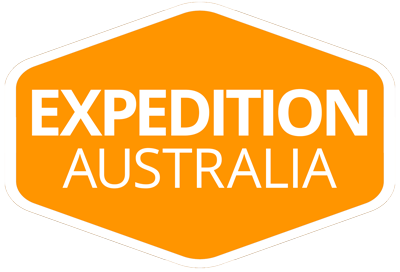If you’re currently planning a Big Lap road trip around Australia then watching fuel prices smash through the $2.00 a litre mark and still climbing has to be causing you some heartburn!
In this post I'll show you how to calculate the actual impact on your Big Lap budget, give you 6 ways to reduce that impact and look at whether prices will continue to climb, stabilise or even drop back below $2.00.
If you'd prefer to watch the video rather than read the post then the watch the YouTube video above.
What's causing the current fuel price spike?
We’ve enjoyed fairly stable fuel prices for the past 15 years being around the $1.30 to $1.50 per litre mark with the exception of 2008 when they climbed up to a little over $1.60 per litre.
This chart shows the Australian National Average Diesel Fuel price from 2007 to 2022.
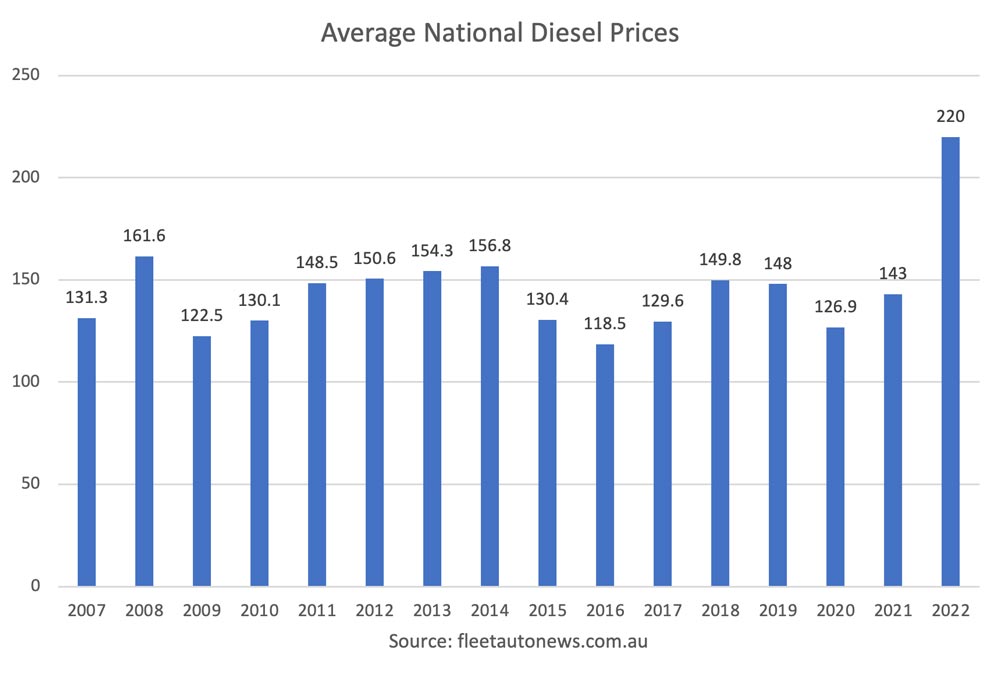
So it's disappointing to see them spiking now to new high’s over $2.20 per litre especially for those people planning to go and drive around Australia.
As if the past couple of years of lockdowns and border closures haven’t been tough enough!!
So what’s causing the spike?
The current narrative is that its the Russia-Ukraine war causing the surging crude oil price but the reality is that prices have been rising for months prior to the invasion of Ukraine on February 24th.
Fuel prices were climbing towards $2.00 per litre as far back as October last year and have just continued their upwards trend into February this year.
According to the Australian Financial Review, “Recovering oil demand amid a relaxing of COVID-19 restrictions around the world also contributed to the hike in February prices“. Source
The Ukraine war has just thrown petrol on the fire (excuse the pun) and pushed prices even higher again as uncertainty around ongoing supply from Russia has Europe, the USA and other countries scrambling to ramp up alternative supply lines.
How will rising prices impact your Big Lap budget?
To calculate how much extra you'll need to budget for fuel for your Big Lap, we'll use the fuel cost calculator which is part of our Big Lap Budget Spreadsheet - you can download a copy of the spreadsheet for free from here.
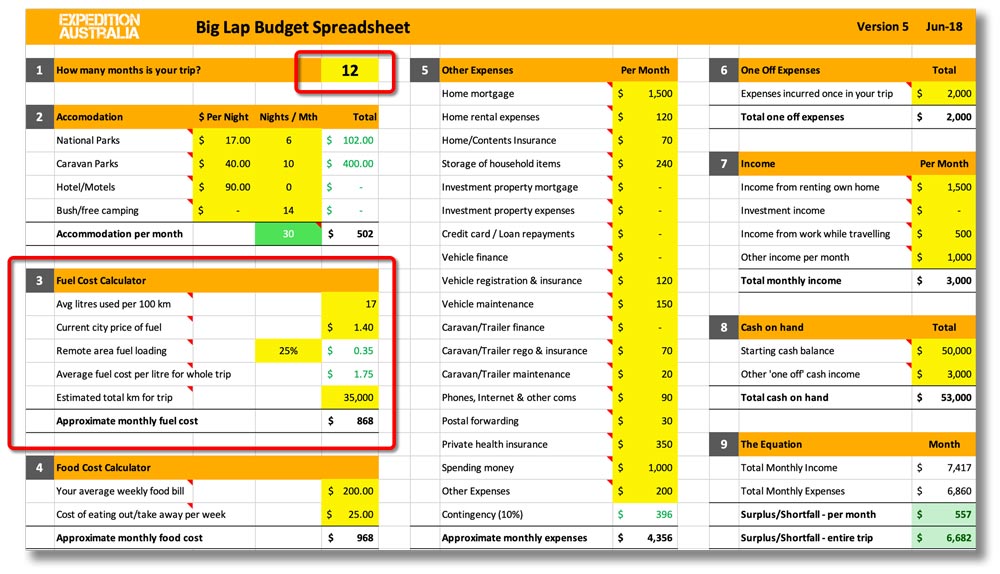
The Big Lap Budget Spreadsheet takes all of the variables related to your situation and your trip plans and shows you how much money you'll need for your trip - so you know how much you need to save.
Fuel is a big part of your expenses so it has a dedicated section on the spreadsheet and that's what we'll use to see the additional cost of fuel from recent price hikes.
You don't need to fill in all of the details on the spreadsheet for this fuel cost exercise, just the areas in the red boxes (see above).
Step 1 - Enter the number of months you plan to travel for in section 1
Step 2 - Enter the details that are relevant to your vehicle and your trip in section 3
| Avg litres used per 100km | This is the number of litres of fuel your vehicle typically uses per 100km. Make sure you allow extra for the fact it will be fully loaded. |
| Current city price of fuel | The price you're currently paying at the pump in major towns and cities |
| Remote area fuel loading | You'll spend a reasonable amount of your Big Lap in remoter areas where fuel is more expensive so this loading is added to the city price to compensate for that. You can adjust the percentage if you think it needs it. |
| Average fuel cost per litre for whole trip | This is the actual fuel price that the spreadsheet uses, taking into account the city price + the remote area loading |
| Estimated total km for trip | Enter the approximate total number of kilometres you expect to travel on your Big Lap. We started with 35,000 because it's fairly typical but you can adjust it to suit your trip plans. |
| Approximate monthly fuel cost | Based on the numbers you've entered, this is approximately how much you'll spend on average each month of your trip across the whole trip |
In the first example below we've used 17 litres per 100km which is about what our turbo diesel 80 Series Landcruiser used on our Big Lap - fully loaded and travelling some pretty rough roads.
The city price of fuel is based on the average diesel price across Australia in 2021.
This gives us an average cost of $886 per month or $10,632 total for the 12 month trip.
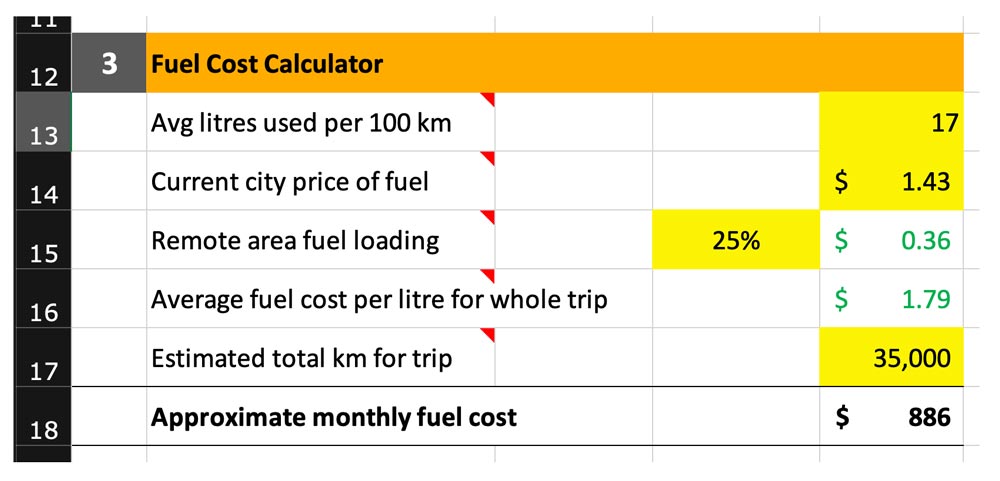
In the next example below I've changed the city price to the current diesel price which is about $2.20 per litre.
The total per month is now $1364 which is $478 per month more than last years price or $5736 extra across the 12 months of the trip.
Ouch!!
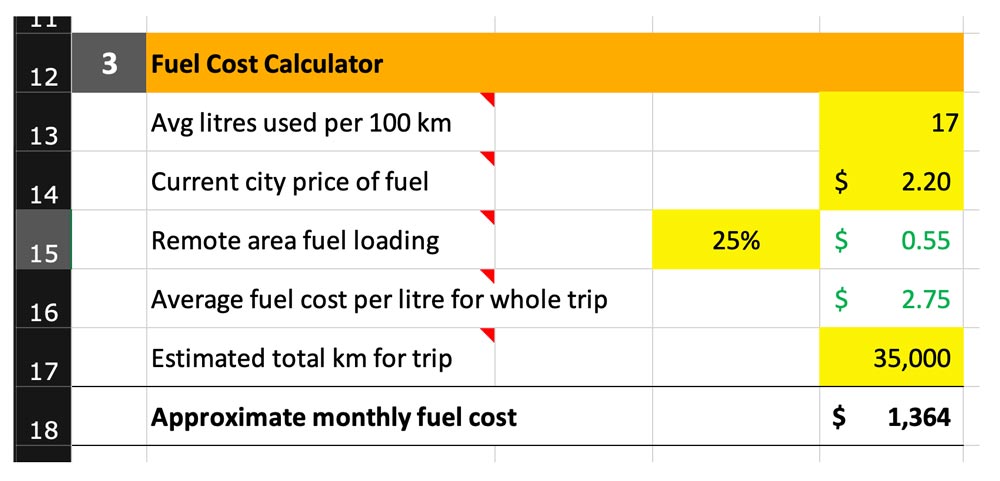
That's a huge hit to your trip budget of over $100 per week.
You can play around with the numbers to make them more relevant to your specific vehicle and trip plans but no matter how you look at it, the fuel cost has gone up dramatically from last year to this year.
So what can we do to reduce that hit and put some of the extra money back in your pocket?
Idea 1 - Travel Lighter
As we learnt the hard way, less is more when it comes to doing The Big Lap.
We lumbered down the road on day 1 of our Big Lap trip fully loaded with WAYYYYY too much stuff.
The end result was we wasted so much time packing and unpacking up our camp trying to find places to put everything and it really took some of the shine off the early weeks of the trip.
Not to mention our poor Landcruiser was working harder than it needed to be.
At the time we were paying around $1.30 a litre for diesel so not super stressed about the fuel economy but with prices over $2.20 it would be a different story.
We slowly but surely got our act together and within a few months had trimmed our kit down substantially and everything just got easier.
So from our experience, and other people we've met and spoken to, you really want to be travelling as light as you possibly can right from day one.
Every extra kilogram you carry is a little bit more fuel burned and it all adds up.
Not to mention how much easier life is day to day when you're not loaded to 100% capacity of your rig.
And of course there is also less wear and tear when your vehicle isn't struggling to drag tonnes of stuff around the country.
- Further Reading: The 80% Packing Rule
Idea 2 - Choose a More Economical Vehicle
While our trusty old 80 Series Landcruiser is an almost perfect vehicle for doing the big lap in many ways, fuel economy is where is falls short.
It's a turbo diesel which is the most economical variant of the 80 Series and averaging 17 litres per 100km isn't that bad compared with the petrol version which would be closer to 25 litres per 100km. Gulp!!
But these days there are much more economical options available.
New 4 cylinder turbo diesel vehicles like the Navara, D-Max, Hilux, Triton or Ranger all quote fuel economy numbers in the high single digits - 7, 8 and 9 litres per 100km.
Virtually half that of the gas guzzling 80 Series and other bigger 4WD's.
Now in reality you'll probably be closer to 10, 11 or 12 litres per 100km when loaded up and towing but still way ahead.
As you can see in the spreadsheet below, just reducing the Avg litres user per 100 km from 17 to 11 drops the average monthly fuel cost to $882 or $482 less than our 80 Series Landcruiser.
That's $5784 less for the year.
So with fuel prices as high as they are, give serious consideration to the fuel economy of your vehicle and weigh up whether it make sense for you to keep the one you have or maybe upgrade.
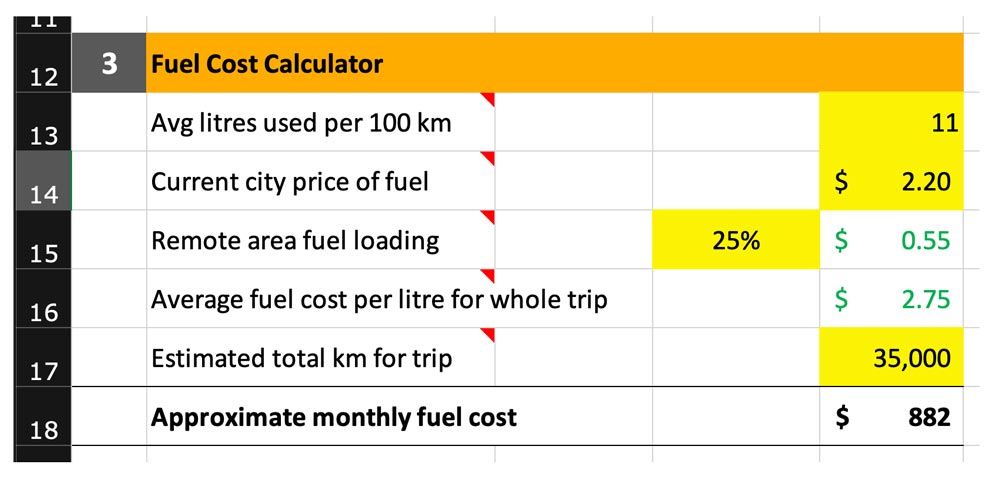
Idea 3 - Streamline Your Rig
Now more than ever before, it makes sense to have a more streamlined vehicle and van/camper/trailer etc.
There are numerous points on your rig that introduce drag and result in your engine having to work harder to push through the air.
- Bullbar
- Spotlights
- Snorkel
- Roofrack & it's contents
- Solar panels
- Shape of your van
- Bikes
- Boats
If you have a low vehicle and a tall flat fronted van then you're basically pushing a wall of air in front of you down the road which will burn more fuel.
Choose a more low profile, streamlined van or trailer.
Install a wind deflector on the front of your roof rack.
Get a tonneau cover made for your roof rack or put everything inside a purpose made poly canvas bag.
Look at every aspect of your rig from front to back and see what you can do to minimise drag wherever you can.
If you manage to save 1 or 2 litres per 100km of fuel it could add up to $1000 or $2000 in fuel savings.
Idea 4 - Be self Sufficient
The three biggest expenses on your Big Lap for most people are fuel, accomodation and food.
In recent years the price of caravan parks has increased considerably along with the increasing quality of the service and facility that a lot of them provide.
It's not unusual to see overnight stays on a powered site as high as $70 - $100 and even higher in peak times.
This has created the opportunity to save money by being more self sufficient and being able to stay in free or low cost camps.
If you can reduce the number of nights you pay for a caravan park by one night per week, it could save you $50 or more which adds to $2500 or more in a year.
There are plenty of free and low cost camping opportunities around Australia if you know where to look.
And the more self sufficient you are the more you can take advantage of them.
- Further reading: Free Camping Your Way Around Australia in 2021
Idea 5 - Carry More Fuel
I know that earlier I was advising you to travel as light as possible but when it comes to carrying fuel, I think this is a false economy.
Generally speaking it's better to have the capacity to carry more fuel and give yourself more options as to where you buy it and how much you pay.
Fuel prices vary significantly from one place to the next and having the option to bypass more expensive fuels stops for a lower cost one further down the track can save you a lot of money.
In our 80 Series Landcruiser we have the original 90 litre tank in the front and have replaced the rear 45 litre auxiliary tan with a 170 litre Long Ranger tank.
This gives us 260 litres capacity stored low and safely under the vehicle.
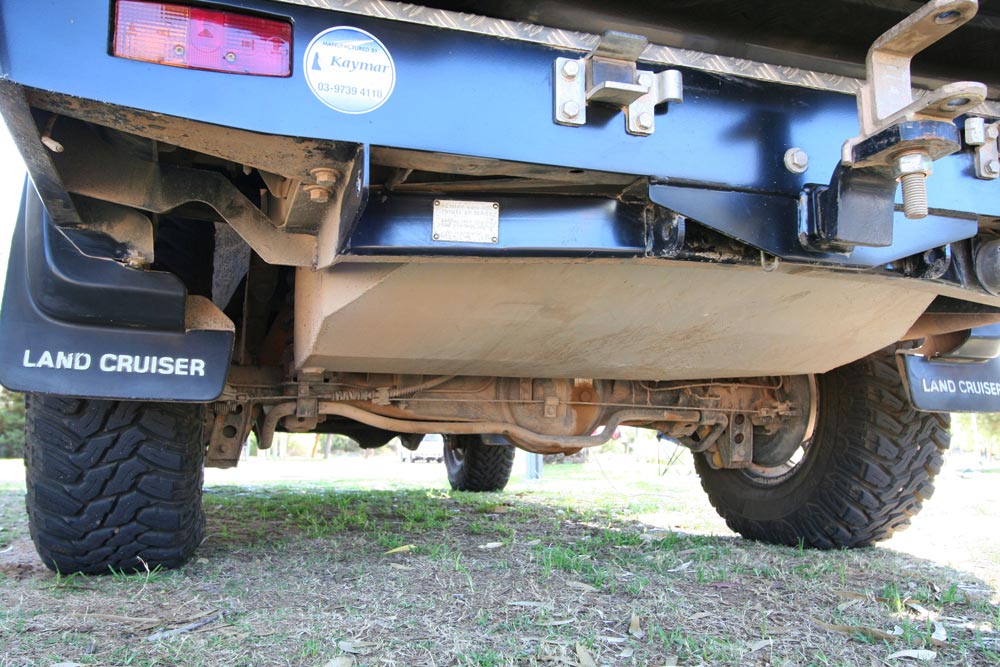
At 17 litres per 100km fuel usage we have a comfortable 1300km range or up to 1500km at a push.
The result is we can fill up in the bigger towns and cities and purchase less from the more remote and higher prices fuel stops.
And the more the price of fuel goes up, the bigger the saving is from carrying more on board.
If your vehicle doesn't have the capacity to install a long range tank then jerry cans are a low cost and flexible alternative. For safety's sake I would avoid carrying them on the roof though.
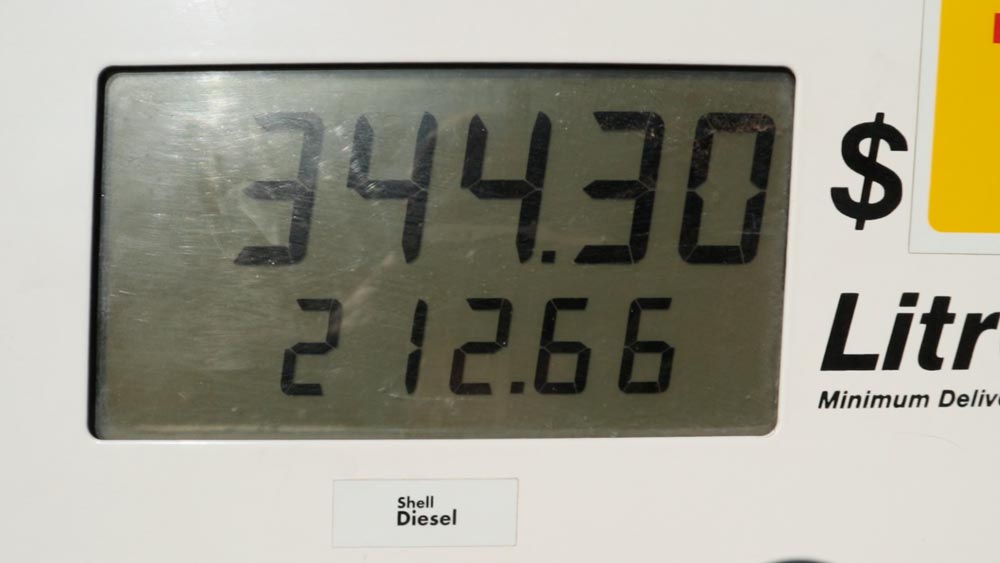
Idea 6 - Plan Your Fuel Purchases With the FuelMap App
Following on from the previous idea of being able to carry more fuel, is the ability to be able to know what the fuel price is at the places your planning to visit down the track.
An app called FuelMap solves this problem.
The app uses crowd sourced information to show users the recent fuel price at most of the fuel stations around Australia.
Users can update the fuel price at any time so in most cases the data is very recent - today, yesterday or the past few days.
While prices do fluctuate, the app will give you a pretty good idea of the prices you'll be paying in the towns you're heading to and can also highlight the fuel suppliers in the area that are on the lower end of the price scale.
You can see a great example in the screen shot below.
The price of fuel at Shell Warumungu (Three Ways) is 249.9 but down the road in Tennant Creek at the United Service Station it's 215.9.
Definitely worth the detour south if you're planning a big fill up.
Purchasing 200 litres of fuel the price would be $68 less at the United in Tennant Creek.
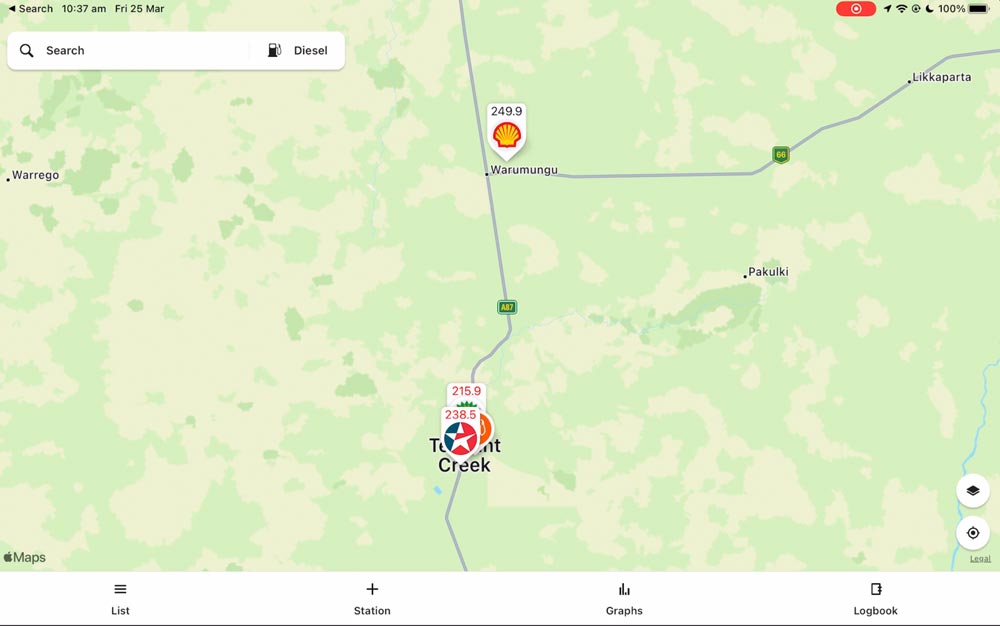
Will Fuel Prices Continue to Rise Or Drop Back Below $2.00 a litre?
I’m no oil price expert and even after reading several articles about fuel prices, none of them offered any insights as to what to expect down the road.
So I contacted my uncle who has worked in the oil drilling industry his whole life and has his finger on the pulse and asked him what he thought was likely to happen.
This was his repsonse:
“Well I would think the prices will come down for sure. Saudi has agreed to increase oil production, the US is drilling again in earnest and . . . there will be some result in Ukraine soon one way or the other.
I think the world has a good plan in place to compensate for the lack of Russian oil in the market place.
If you believe the latest federal poll that Labor will win the next election then I think it would be safe to say there will be some form of reduction in the fuel price excise.
Definitely not 44 cents but 20 cents possibly.
I think fuel will land around $1.70 - $1.80 in the near term or around May sometime.”
Time will tell if his prediction is accurate but I certainly hope that it is.
I noticed just today the the liberal government are signalling a potential cut in the fuel excise or a freeze on raising it so we may get a tax cut regardless of who wins the next election.
At the end of the day we can’t control the price of fuel - all we can do is try to use less of it!
So don’t let it derail your big lap plans because at the end of the day there will always be things we can’t control and road blocks in the way.
We just need to keep climbing over them and get to the start line no matter what!

